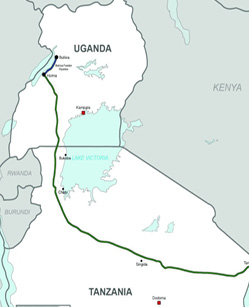(GIN)—Construction of a multi-billion dollar oil pipeline has gotten the go ahead from local officials to carry crude oil from western Uganda to the Tanzanian port of Tanga. But a growing wave of opposition is mounting to the heated pipeline that will pass through high-biodiversity areas and displace thousands of people.
The pipeline will run 898 miles from Uganda’s Lake Mwitanzige in the Albertine Rift to the Indian Ocean port of Tanga in Tanzania.
Uganda’s reserves could last 25 to 30 years with a peak production of 230,000 barrels per day. However, on March 1, more than 250 local and international organizations addressed major banks in a letter calling upon them to refrain from financing “the longest heated crude oil pipeline in the world,” according to the AFP news agency.
The letter cites “extensively documented risks,” including “impacts to local people through physical displacement … risks to water, biodiversity and natural habitats; as well as unlocking a new source of carbon emissions.”
Civil society groups led by the African Institute for Energy Governance (AFIEGO) have been urging the governments of Uganda and Tanzania and pipeline company to call off their plans as some of the people affected by the pipeline have not been compensated and that the oil developments are taking place in an ecologically sensitive conservation area.
The oil project has already contravened Uganda’s Environmental Impact Assessment (EIA) Regulations, Dickens Kamugisha, AFIEGO’s CEO said, by rushing through public hearings on the project with a presiding officer who was the former minister of energy and mineral development.
Officials from Uganda, Tanzania, the French company Total, and the China National Offshore Oil Corporation (CNOOC) gave final approval to the $3.6 billion project cloaked in secrecy about details of the project between French oil giant TotalEnergies, the pipeline’s operator, and Ugandan President Yoweri Museveni. The legislation hands powers to a secretive “Host Government Agreement,” opponents say, that may threaten the environment and trample human rights.
A Ministry of Energy and Mineral Development spokesperson defended the project, saying it was approved “in accordance with the Rules of Procedure of Parliament including 45 days for the committee to report back to Parliament. They considered the bill and engaged several relevant stakeholders and published public announcements calling for memoranda.”
But Diana Nabiruma, senior communications officer of the Africa Institute for Energy Governance (AFIEGO) in Kampala, said the public was only given five days to comment. “It was difficult for affected communities to input,” Nabiruma said, adding they live far from Kampala, Uganda’s capital.
Details of how revenues from the extracted oil will be shared weren’t made available until the second reading of the bill. “This deprived the Committee [on Environment and Natural Resources] of adequate information,” shadow minister Christine Kaaya Nakimwero said. The project construction and decommissioning plans were also unclear, she added.
“Without access to those agreements, small-scale farmers, tourism operators, foresters, fisherfolk and others in the green economy and the general public cannot be sure that their interests will be served by the EACOP Bill or make appropriate comments to ensure a good EACOP law,” the Inclusive Green Economy Network–East Africa wrote in a statement to parliament.
“There should be full disclosure,” Nabiruma said. “We are commenting blindly.”
“Local communities that for centuries have depended on these ecosystems could now be sharing polluted water with industrialists,” said Rajab Bwengye of the National Association of Professional Environmentalists, a Ugandan NGO.
In 2017, a WWF report cautioned that the pipeline “is likely to lead to significant disturbance, fragmentation and increased poaching within important biodiversity and natural habitats.” EACOP will cross through Taala Forest Reserve on Uganda’s southern border, as well as passing through the drainage basin of Lake Victoria (‘Nnalubaale in the Luganda language), Africa’s largest lake.
There are already worrying signs of damage to the environment, said Dickens Kamugisha, CEO of AFIEGO. “A huge road has been constructed through Murchison Falls National Park for carrying equipment for oil exploitation,” he told Mongabay. Road construction machinery and heavy trucks have led to animals fleeing the park, he said, creating human-animal conflicts in surrounding villages.
Near the oil fields, Bugoma Forest and Budongo Forest, home to at least 1,000 chimpanzees, have already suffered encroachment in recent years. Roads and in-migration linked to the oil project are opening up these biodiversity hotspots to destruction, Kamugisha said. Environmental activists say biodiversity hotspots like Bugoma forest are threatened by the pipeline.
A spokesperson for TotalEnergies denied the pipeline and the oil exploration and production facilities would encroach on forests.
The East Africa Crude Oil Pipeline (EOCOP) resettlement plan estimates that 4,000 people will be affected by the pipeline. NGO Oxfam estimates the toll will be much higher, with some 12,000 families losing their land.













